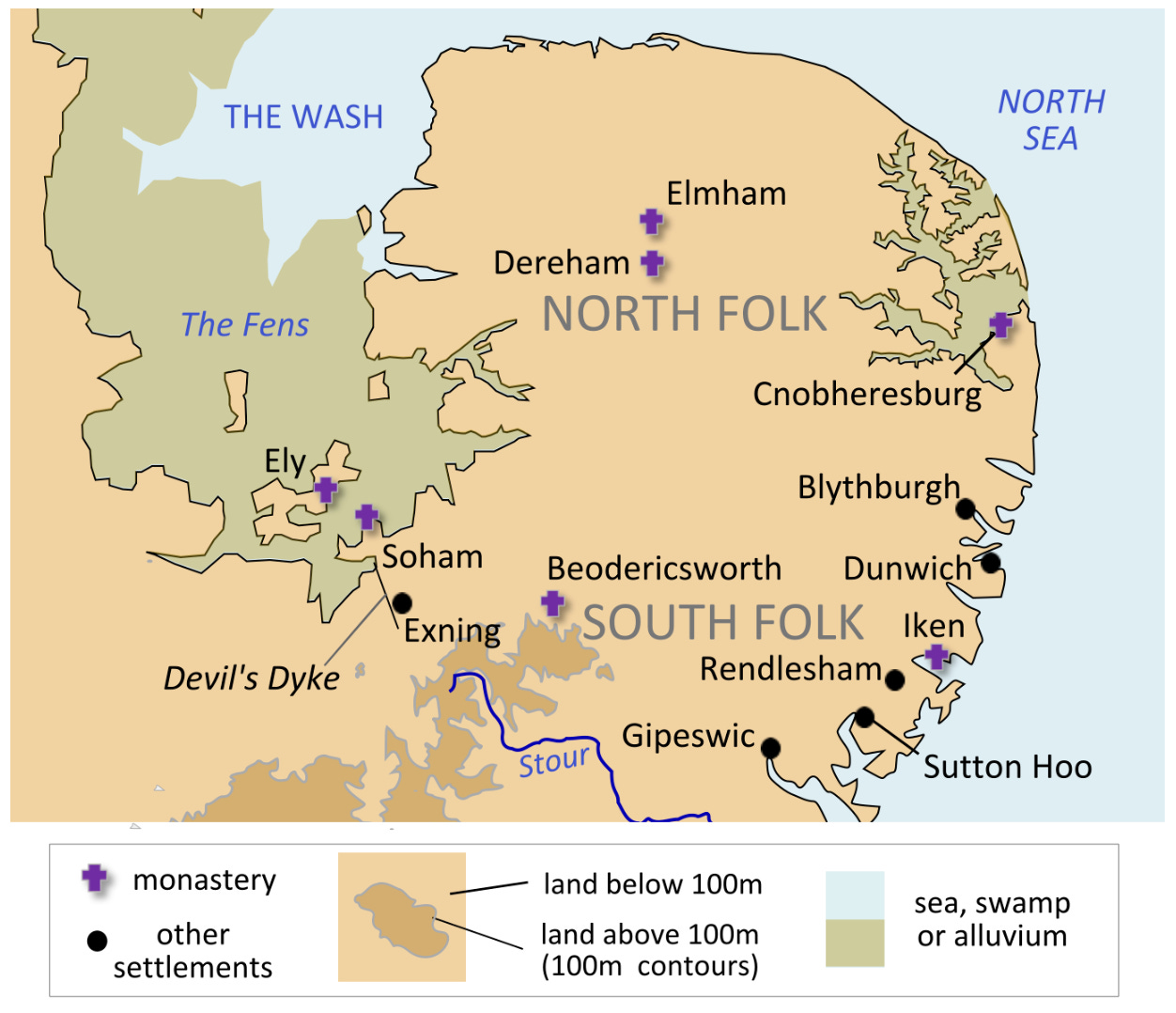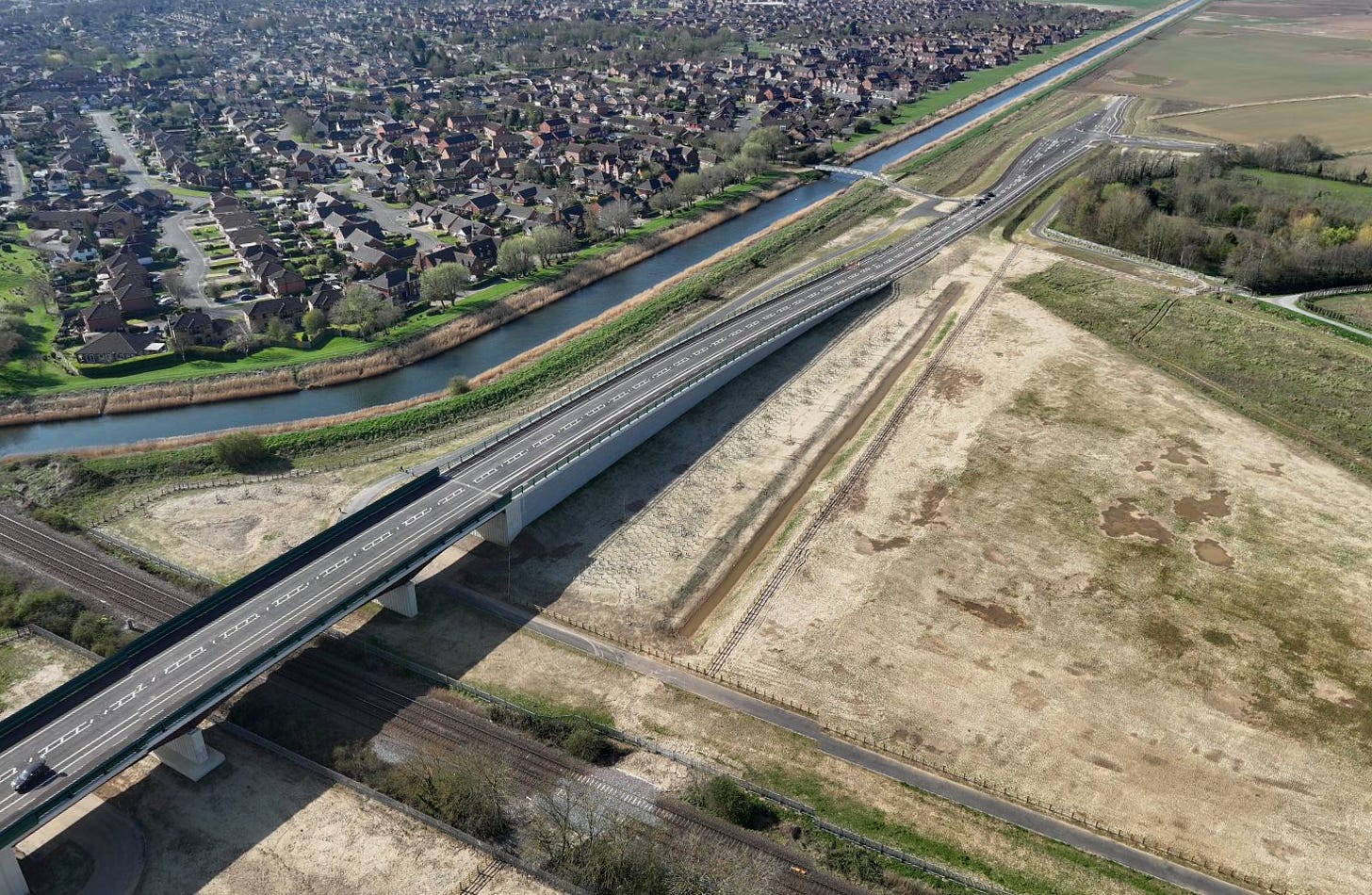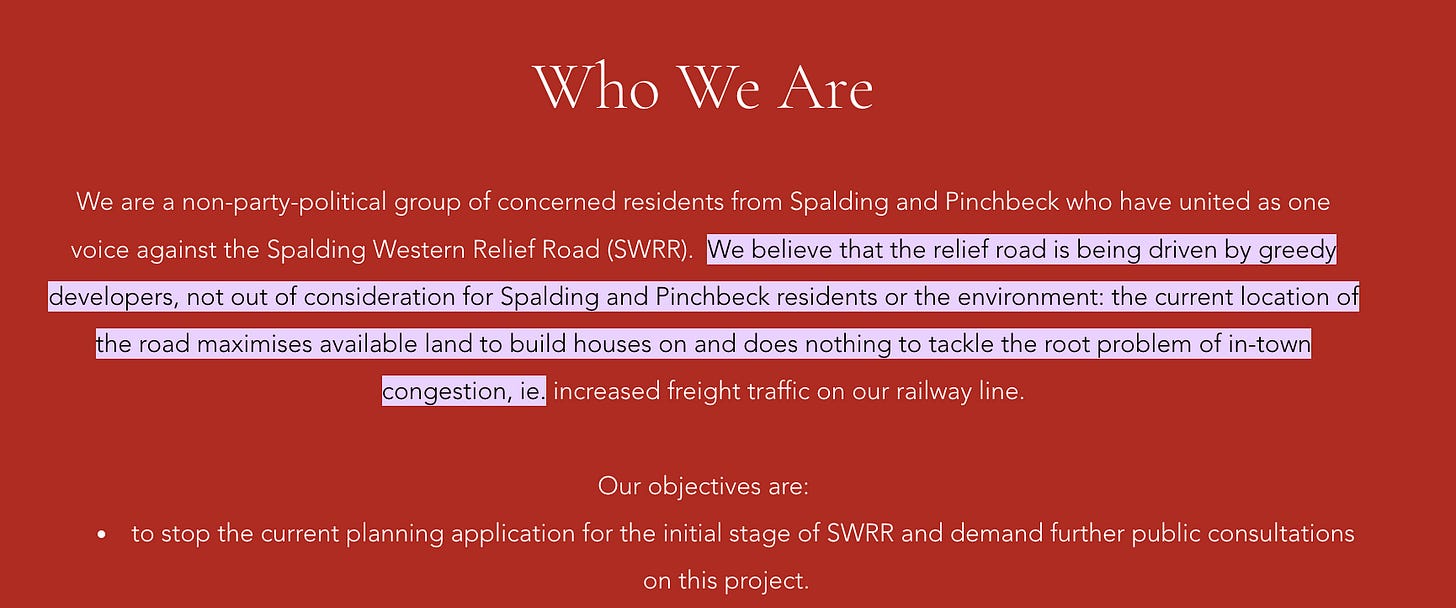Aspic Britain and The Bridge to Nowhere
You'll never guess what led to a road in Lincolnshire ending abruptly in an unremarkable field
This week’s newsletter contains: a bonkers bridge, badly acronym’d nimby groups, Rudyard Kipling, badgers, Roman historians, savoury jelly, and a lesson for King Cnut.
Let’s dive right in!
Lincolnshire County Council became the subject of ridicule last month, as their ‘Bridge to Nowhere’ hit the national press. The Spalding Western Relief Road has been in the works since at least the start of the last decade. But in the works, it is arguably no longer.
Designed to ease congestion on the A16 through the market town of Spalding, and to support new housing in the area, its delivery has - naturally - not been particularly smooth. Today the unfinished project stands as a physical monument to modern Britain’s comic inability to build.
This is more than a story of an incompetent council. It’s a story of local opposition, spiralling costs, and attitudes against progress. A microcosm of everything wrong with Aspic Britain.
Let’s rewind to 2022, when Lincolnshire Council began constructing a new road without having been able to secure the funding for every section of it. The council’s gamble had a kernel of logic to it: if they waited longer, costs would spiral further. They hoped there would be more money to deal with all of that down the line. Sadly for the council, there hasn’t been.
Yet the story of this costly bonkers bridge begins long before 2022. As with anything that people attempt to build in Britain, it has been decades in the slow and painful making.
While original proposals for the road can be traced back to 2006, work began in earnest half a decade later, with the scheme’s consultation reporting back in 2011. This was the year Osama Bin Laden was shot, London rioted, and Japan suffered a tsunami knocking out the Fukushima nuclear power plant.
In the time since, Japan has returned hundreds of thousands of citizens to the evacuation area and began once again exporting Fukushima seafood. China has built 20,000 kilometres of high-speed railway. Meanwhile in this part of Lincolnshire, we have managed to build less than one fifth of one road.
From the start in Spalding, local opposition to the project was significant. By November 2011, the council had put together a response to the public consultation. It listed:
Concern about the visual or noise impact of the road
Complaints the scheme will not relieve traffic congestion
Complaints the routes will be damaging to allotments and farmland
Complaints the relief road will direct more traffic onto surrounding roads
Complaints the scheme does not provide value for money
Complaints that the road is not wanted or is not necessary
Complaints that developers will be the main beneficiaries of the road
Complaints that wildlife needs to be protected
Complaints about a group of preserved trees
This is just a small selection of the complaints and concerns raised with the council. Just seven (7) responses to the consultation questionnaire were of the view that “the relief road should be built as soon as possible”.
Fast forward eight years to 2019, and Lincolnshire County Council finally submits planning applications for the first two of five sections of the road, catalysing the formation of the uber-nimby group Spalding and Pinchbeck Against the Relief Road (SPARR).
SPARR say on their website “the relief road is being driven by greedy developers, not out of consideration for Spalding and Pinchbeck residents”.
Like thousands of groups across the country, each one stylised with the sort of garbled initialisms you would normally expect from patriotic American legislation, SPARR went to spar with the local authority, and the government.
The relief road should have been a relatively uncontroversial road to build. Under Town and Country Planning regulations, only highways longer than 10km with dual carriageways must be automatically subject to a full environmental impact assessment.
Fortunately for Lincolnshire County Council, Spalding Western Relief Road was to be just 6.5 km in length, and a single-carriageway scheme. So it fit none of the criteria for an automatic full environmental impact assessment.
Unfortunately for the council, and many like them, they went ahead with a full environmental impact assessment anyway. Often councils act to pre empt intense opposition, and gold plate their planning applications accordingly. This means more money spent on consultation. More money spent on impact assessments. More money spent on finding out what more money could be spent on.
SPARR, with the help of local MP John Hayes, even got the anti-development quango Natural England involved with meetings about the project.
As a result of all of these interventions and years stuck in the planning process, the council promised to search for water voles and live-trap the wriggly little things to relocate them to suitable habitats nearby. Badger setts were to be monitored with a view to rehousing badgers under licence. Any lost habitat would be compensated by creating extra new green areas.
Wind in the Willows has much to answer for.
The council even pledged to schedule any tree felling or scrub clearance outside of traditional bird nesting season. Preliminary works on the project were delayed as a result.
For all the costly mitigation for this short stretch of road, opponents of course remained sceptical, arguing that no mitigation can fully compensate for the “devastating effect on local wildlife habitats and protected species”.
This is a persistent theme in British planning. We saw it too with HS2. Opposition groups demand countless cost-increasing interventions, with literally zero intention of backing down once those cost-increasing interventions were committed to. Costs rise, delays increase, and these become new sticks with which campaigners can beat the developers. Despite the campaigners asking for the sticks in the first place.
It’s not all too dissimilar to when the Vikings invaded Anglo Saxon England. Upon Viking invasion, the Anglo Saxons paid them off with tribute known as Danegeld. In 991, the Vikings were paid 10,000 Roman pounds of silver in order that they - in the words of former Defence Secretary Gavin Williamson - “shut up and go away.”
But go away they did not. The Vikings learned that they could extract more and more Danegeld from the Anglo Saxons who simply did not want to fight. All it took was a fresh invasion threat. Kipling puts it best…
It is always a temptation for a rich and lazy nation,
To puff and look important and to say:–
"Though we know we should defeat you,
we have not the time to meet you.
We will therefore pay you cash to go away."
…
And that is called paying the Danegeld;
But we've proved it again and again,
That if once you have paid him the Danegeld
You never get rid of the Dane.
Like the Vikings that came before them, time and time again the nimby lobby is appeased with environmental schemes; badger relocation, bat tunnels, Biodiversity Net Gain requirements. And yet, to paraphrase Kipling, you never get rid of the nimby.
It’s a lesson the Government has not yet learned, as last week plans were revealed to amend the flagship Planning and Infrastructure Bill - making it harder and slower to build new projects than otherwise would have been the case. Under the amended Bill, it’s unlikely the Spalding Western Relief Road would be built any faster.
All of these interventions and objections to what should have been a minor and inexpensive road building project have led to more delays, greater costs, and what is now a bridge to nowhere. To this day, no planning application exists for Sections 2–4 of the project. It stands as a totem to incompetence.
But let’s zoom out for a second and consider what part of the nation it is whereof we speak. Spalding is in the Fens. A part of the country that didn’t really exist as solid land until the 17th Century. It existed as marshes, swamp, sea, and alluvium. England’s pleasant pastures green it was not.

There is a temptation to think of England as an unchanging land, blessed by the holy Lamb of God and pleasant pastures, all since ancient time. But history disagrees.
When the Romans stumbled upon the Ancient Britons, they found a swamp dwelling people.
Herodian of Antioch wrote "Most of Britain is marshland because it is flooded by the continual ocean tides. The barbarians usually swim in these swamps or run along in them, submerged up to the waist."
Cassius Dio even claims that “they [the Ancient Britons] plunge into the swamps and exist there for many days with only their heads above water”.
According to these Roman historians, the Ancient Britons sound almost aquatic. While no doubt somewhat exaggerated, these descriptions do give us an indication of what life was like in much of the country before land was reclaimed and properly cultivated. Until the modern era, much of Eastern England was largely below water for much of the year.
The rolling hills we think of elsewhere in the country were not pleasant pastures either. Many were covered by ancient rainforest. The pastures that William Blake pens in perhaps the most famous natural portrait of England ever written, were ironically man made.
And did those feet in ancient time,
Walk upon Englands mountains green:
And was the holy Lamb of God,
On Englands pleasant pastures seen!
And did the Countenance Divine,
Shine forth upon our clouded hills?
And was Jerusalem builded here,
Among these dark Satanic Mills?
So no, those sandalled feet did not walk upon England in ancient time. And even if they did they did not walk upon mountains green. And just for good measure there were very few pleasant pastures for any Lamb of God to be seen in either.
Blake’s poem is rousing stuff but it is the work of purest fiction. And nimby fiction at that. The mills that were being built in his time were neither the stuff of darkness nor Satan. They were the lifeblood of the country and what took this place from third world to first. First.
In fact initially it was Dutch windmills and then English steam pumps that made the semi-industrial draining of the fens possible and permanent.
A huge effort was made to drain and claim land from the 1600s onwards, all in the face of fierce local opposition from fishermen who lived in the area. No doubt the eelers of the Isle of Ely were distraught that the government was taking away their livelihood by pumping away all that water. And the beautiful city’s island status at that. But as this was a good few hundred years before the Town and Country Planning Act (1947), so the works went ahead.
The land beneath the Spalding Western Relief Road isn't 'natural'. It's man made. Man claimed.
And yet today, many groups - SPARR and their like - argue that nothing can be changed about this country. That we must freeze our land in aspic. Thank goodness the Ancient Britons were not quite as effective as the acronym’d nimbys of today, otherwise we might well all still be living in swamps.
In fact the engineers and industrialists of the 17th, 18th, and 19th Centuries who didn’t give two hoots about the eel habitats they were wantonly destroying could teach the famed King Cnut a lesson. The penultimate Danish King of England legendarily attempted to stop the incoming tide, to demonstrate that even a King plays second fiddle to the supreme power of God.
Where King Cnut (almost certainly apocryphally) submitted to God, however, in the modern era we have not. We have moulded the land to our purpose. We have turned sea to shore, and elsewhere dug soil and clay to hold fresh water (albeit not in Britain since 1992). We have been the masters of the universe, and the world is better for it.
Modern day Cnuts do exist, of course. Those who tell us we cannot, or must not, command nature. While we went from being unable to control the tide, to Dutch engineers and Victorian industrialists proving the opposite, today much political discourse has returned to Cnut era thinking. The pretence that rising sea levels would be an extinction event. That humans can’t adapt.
Today’s Cnuts post pictures online of ‘how much of Britain will be underwater by the year 2100’ thanks to climate change. Pretending of course that no flood defences could possibly be built. Forgetting of course how much land humans can and have reclaimed from the sea.
There is some suggestion that the location of Cnut’s demonstration of monarchical ineptitude was a little island upstream from the City of London - called Thorney Island, where Cnut set up a royal palace. The patch of soggy land was subject to the tidal River Thames, and cut off from the mainland by a delta in the ancient river Tyburn.
The area is now known as the very much not-island of Westminster.
Thorney Street, which wraps around the MI5 building by Lambeth Bridge, is pretty much the only modern monument to the far more aquatic history of the area.

If we were to travel back in time a thousand years this country would be utterly unrecognisable. And for the worse. The story of human progress and growth is the story of how we have changed our environment. Had we adopted William Blake’s attitude towards industrialisation and ‘dark satanic mills’, Britain would never have ruled the waves.
Had we adopted the SPARR attitude to local development in the 1700s, there wouldn’t be a Spalding to worry about building a relief road around. We could have all made do with a canoe.
The attitude that prevents construction would have prevented farmers felling trees and creating the beautiful patchwork quilt of family farms and hedgerows dividing them across the country. The grassland we know and love would never look as it does today without drainage and grazing. And the lifespans we all enjoy today would not have been possible without the urbanisation and economic development that roared through the Victorian era.
It is of the utmost arrogance to think that we, today, have a right to freeze our country in aspic. That we have the conceit to declare this particular point in time as the perfect immovable arrangement of our land. That we have the sheer hubris to choke off our growth cities with green belts set by bureaucrats now long since dead.
Imagine if we had effectively frozen the size of our cities not 70 years ago, but 200 plus years ago. Amongst the biggest cities today would be York and Norwich, and only London would have the capacity to house more than one million people. We would never have expanded to become the global hegemon. We’d be nothing.
Manchester would have remained a relatively small market town. Middlesbrough would not even exist.
It sounds ludicrous but that is exactly what Aspic Britain is doing today to cities like Oxford and Cambridge, which could be the biggest drivers of growth in the country but are artificially constrained by a ‘green’ belt penning in our most globally important tech and biotech sectors to medieval sized settlements.
The attitude against development, be it road or rail or reservoir, is what has led to Britain’s stagnation. It’s what has led to the remarkable statistic that GDP per head in Poland is due to overtake Britain within a decade. While we stood still caring more for bats than Brits, places like Poland have focused on development.
Thank God Aspic Britain did not arise before the industrial revolution. But pity the fact that Aspic Britain is holding this country back in so many ways today.





